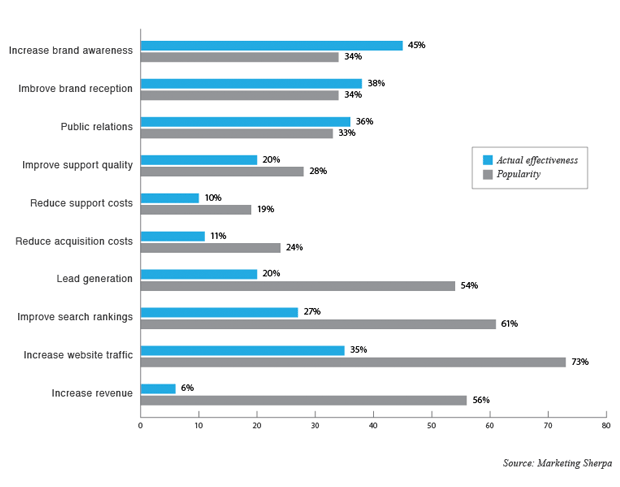Social Media and Content Marketing. A Guide for B2B Marketing Managers
On the Internet, marketing trends come and go faster than ever. Do you remember frames, flash intros, and even viral videos? Marketers treat these trends predictably, first glorifying, then vilifying, then abandoning trends as they rise and fall.
At Atomicdust, we gauge trends by questions our clients ask. By that measure, social media is off the charts. Discussions about new websites are frequently punctuated with questions like, “What about Twitter? What do you think of that?”
Here’s what we think: social media isn’t a trend. Sure, individual channels like Twitter or Facebook are. But the idea of creating and sharing information, or content, is here to stay. We see social media as one of the most effective ways to draw attention to the information you post online.
To have the biggest impact with social media, it’s important you begin with the basics. It’s how we always start – and it’s where we’ve started with this guide.
Know your brand.
Define your goals.
Know your audience.
Find the content.
Develop content strategy.
Promote your content.
Measure your impact.
Know your brand.
When you build a house, you can’t begin by putting up the front door. You start by laying the foundation on which everything else will be built. That’s the approach you should take with social media.
You have to know your brand before you can talk about it.
So what does that mean? It means you need to define:
- your position in the market
- who you are
- and how your audience views your company
Most importantly, you need to describe, in words that matter to your audience, what sets you apart from your competition. That is to say, your unique selling proposition. Outlining this at the outset puts you in a greater position to clarify your mission, unify your corporate culture and hone the focus of your business.
You might dismiss this as marketing jargon, but we believe it’s the most critical part of any marketing effort. Unfortunately, it’s also the most difficult, particularly for established companies who are looking for a new focus. Refining your brand – or rebranding entirely – can be more difficult than starting from scratch as you battle to change internal and external perceptions.
Part of knowing your brand also involves discovering whether it’s not for you. We believe that B2B brands can benefit from social media on many levels. It connects customers and prospects to people within your organization, enhancing sales, support and service. The impact can be wide-ranging.
But does your B2B brand need social media to succeed? No, not at all. Not every business has to be on Facebook or Twitter to be successful. It’s not for everyone.
Is it for you? Here are some starter questions that can help you find out:
- Do you have an ongoing supply of content you want to share?
- Is your audience engaged on social media channels?
- Are you prepared to monitor and participate in online conversations?
Define your goals.
As with any marketing effort, you must start with a defined goal. Ask yourself: What do you hope to achieve with social media? This is an important question, both to align internal expectations with reality, and, in some cases, to determine if social media is a good fit.
Some common goals we have seen include driving sales, promoting white papers and web content, driving event registration and improving customer relationships.
Do your goals align with what social media can deliver? This chart might help you decide:

Of course, from goals, you get measurement – and that’s the question our clients ask most often. What’s the ROI? It can be difficult to prove, because social media works for intangible things like “brand awareness”. If you’re looking at it from a dollars-to-dollars perspective, it can be hard to quantify.
However, we encourage you to look at social media like this: “What’s the ROI in playing golf with a client?” Social media is an extension of your relationship-building activities. Some businesses see the value. Do you? That could be the single, most important question you answer.
Know your audience.
It sounds simple, but you should know who you’re talking to before you start using social media. Of course, with B2B brands, this can often include multiple decision makers over a long sales cycle. We work with our clients to build demographic and psychographics of key stakeholders and targets that include:
- Gender/ Age
- Tone
- Occupation
- Why are they visiting your website? What are they looking for?
- Why are they using social media to follow you?
- Other brands they might like
- Topics they can relate to (nursing, education, technology)
These profiles will enable you to tailor specific content to your most important targets.
Find the content.
Content is anything and everything. It’s the information you post online, be it web copy, videos, articles, pictures, white papers, presentations and newsletters. Of course, your goal is to have as many people as possible read and share your content. That’s what social media is all about.
Most of our clients use social media to share content they create – or that we create for them. We also use social media channels to share related, third-party content. Third-party content refers to articles or posts that someone else creates – for example, a magazine article – that your audience might find useful.
The most effective content:
- positions your company as an industry leader
- builds relationships with your key audiences
- and encourages positive, thoughtful conversations.
Develop content strategy.
Once you have a good base of content, your content strategy gives you a plan to share it – and tells you what to create next. A sound content strategy keeps your audience engaged with your brand. And it’s one of the best things you can do to raise your profile on search engines.
We get a lot of questions about content strategy – here are answers to a few of them.
What content is right for your business?
There’s no simple answer – but the goal is to use your content as an opportunity to reinforce your brand’s position in the market. We encourage you to look at content from your audience’s perspective. What will they find interesting and engaging? And what will help them learn more about your company? What information can you convey that will make their jobs easier?
Who should create the content?
Anyone who is a thought leader in your organization can create content. Typically, these are members of the executive team, which can be a tough sell. They might not see the value, or want to take on the extra work. Content creation is hard – and they might not want to expose their thinking.
In their place, the marketing department (or outside agency) can serve as an editor, or even ghostwriter, for the thought leaders. This is fine, but not ideal. Authenticity is a huge buzzword in social media, and when marketers – or people who are one step removed from your industry – create content, your audience knows.
The best compromise is for executives to provide outlines or drafts for the articles, drawing on marketing teams for assistance in polishing, posting and promoting content.
How do you publish the content to the web?
In the early days of the web, updates involved in-depth technical knowledge. But today, a Content Management System (CMS) makes it fast and easy. There are several free and open-source or low-cost CMS solutions available. Most are easy to use and implement, with the help of an experienced web developer. At Atomicdust, we prefer WordPress and ExpressionEngine, depending on the scope, purpose and goal of the site.
How often should you post content?
Ideally, you should try to post at least 2,000 words of new, relevant content every month. Think of this as one large article, or four smaller ones. This isn’t an arbitrary number: there’s a method to this madness.
First, you will dominate in Search Engine Optimization, or SEO. There’s nothing better for SEO than fresh content on your website. With that frequency and volume of relevant posts, your website will rise to the front pages of Google when your customers and prospects search for key industry terms.
Secondly, your key audiences will see your brand as the go-to resource for information on the topics you cover. They’ll know you’re dedicated to providing insight and helping them do their jobs better.
Lastly, a solid content strategy gives you a steady stream of content to distribute in email newsletters and a host of social media channels.
Promote your content.
So, you’ve posted the content to your website – you’re only halfway there. The next step is to get more eyes on your on it. Here’s how to do it.
Post article summaries on your homepage. The new content you post in your blog or news section should also appear on your homepage, under “Latest news” or “Latest posts”. This ensures visitors know your site has been updated, and greatly enhances SEO by adding keyword-rich content on a regular basis.
Summarize and post articles on Facebook. Every time you post an article, link to it on your Facebook page, along with a short headline or summary. The best part of Facebook is that comments, likes and shares further spreads your content.
Post on Twitter. On Twitter, you have 140 characters to say whatever you want. You can post links, quick ideas, or anything that’s relevant to your audience. If you’re posting links, we suggest summarizing your content with something descriptive, such as: “Atomicdust tells how they use social media for B2B brands,” add the link and then tweet it out.
Get Linkedin. Linkedin is, essentially, a professional version of Facebook. You can summarize articles and post links to them on your company’s Linkedin page, and on your employees’ individual profile pages. In addition, you can use the same content to spark discussions in groups that people in your target audience might join.
Start a company newsletter. A solid content strategy means you’ll always have material to send out in a company newsletter. You can send these out via e-mail, add them to your website or even the old-fashioned way, in a printed piece. It’s a powerful way to reinforce your brand.
Submit to other blogs. Create a list of industry websites your audiences might visit – and submit articles for publication. Having your company’s thought leadership content published by trusted news sources builds credibility and expertise – plus it’s another powerful addition to your SEO strategy.
Measure your impact.
Is it working? Have you chosen the right social media channels to drive traffic to your site? One way to know is to measure visitors to your site using a tool like Google Analytics.
Google Analytics lets you actively monitor the keywords people use to find your website in search engines, and lists key traffic sources (like Facebook, Twitter, Linkedin, etc.). You’ll be able to see which pages are visited most often, and how long people stay on your page. It’s valuable information that can help you refine your content strategy.
With social media, you can keep track of the number of followers (on Twitter and Linkedin) or “likes” (on Facebook) you have. More importantly, you’ll want to track interactions with your audience – comments, @mentions, retweets, etc. Most social media channels can be configured to send you an e-mail when someone talks about your company or comments on or shares your content – so you can track your online impact.
It gets easier as you go.
As we’ve said above, the most difficult part of any social media strategy is getting started. Most companies simply don’t know where to begin – and aren’t even sure of the benefits of doing so. Of course, once you’ve done the hard work and your brand is in place, and you’ve established your content strategy, social media becomes a natural extension of your marketing plan.
We hope this guide answered some questions you may have had about social media, and that you will find it helpful as you develop your own content strategy. If you have further questions, please do not hesitate to get in touch with us.



